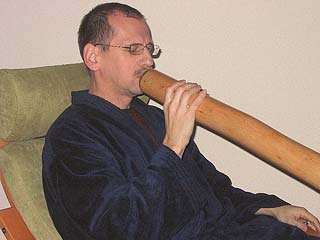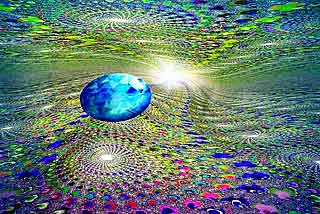| Didgeridoo and Meditation |
|
(in cooperation with Clemens van Brunschot, The Netherlands, www.clemensvanbrunschot.nl)
Introduction Whole libraries could be filled with what has been written about meditation. Depending on a person's goals, the word is associated with relaxation, concentration, energy, connectedness, emptiness, enlightenment, God. Each of these concepts represents something where today's men and women, amidst the turmoil (or craziness?) of the modern world, are longing for - sometimes desperately. There are many paths in meditation and some of the most successful ones use sound as a tool in order to attain a person's goals. This is where the didgeridoo fits in nicely, because its sound goes deep - not only in a physical sense, but certainly also in a psychological sense. Visitors of this web site have made it perfectly clear, in their comments on the effects of the didj sound, that the link between the didgeridoo and meditation is naturally made. That is why on this page the relationship between the two is investigated and methods are suggested to effectively use the didj as a tool in meditation practice. Sound and Meditation Before we turn to the didgeridoo, the function of sound in meditation needs to be clarified. Most of meditation is about clearing the central nervous system from the stream of thoughts that go in all directions, by Taoists called the 'monkey mind'. As soon as the mind is stilled, the dominance of Beta waves in the brains (with a frequency of 13-40 cycles per second - Hertz or Hz) is replaced by a dominance of Alpha waves with a frequency of 8-12 Hz, representing a mental state of rest and focus, yielding increased capabilities for creativity. Going lower, to Theta waves (4-7 Hz) and even Delta waves (0.5-3 Hz), we enter states of well-being and deeper meditation, with more room for spirituality, the 'Higher Self', God.
Sound is a great tool to put your mind at rest. It is used in many cultures in many forms: drumming, singing or chanting, reciting mantras or prayers, etc. (and certainly didj playing, but more about that in the next section). Arnold Mindell, in 'Working on Yourself Alone - Inner Dreambody Work' (1990), writes: "Auditory signals induce trance states in two ways. They either blot out the ordinary internal dialogues or switch the focus to proprioception (= feeling your body, CvB), since rhythm and music can also be felt physically, not just heard. We all know that we can feel singing through the vibrations in our lungs, back, throat and head." Sounds are most effective if used actively: making the sound yourself, provided that it does not take too much mental effort to do so. Didgeridoo The sound of the didgeridoo shows a high representation of low frequencies, typically in the range of 50-200 Hz, which has a high physical impact on the listener and performer. The page on Didgeridoo Sound Healing on this web site shows that the distribution of frequencies also contains not only harmonics going up to 1000 Hz but also extremely low frequencies way below the Alpha brainwaves, in the same area as the rhythms of drumming commonly used in shamanistic rituals of Aborigines and peoples all over the world, time-tested to help in inducing altered states of consciousness. This may help to explain why the didgeridoo many thousands of years ago found its way into Aboriginal shamanistic and healing practices. Extremely low frequencies are also produced by interference between two didj frequencies close to one another: one from the drone or harmonics, the other from vocals used. Part of the benefits of playing the didj is probably due to circular breathing as well as simply breathing more than usual. In order to play didgeridoo one has to breathe a lot. The more you breathe the better your didj playing gets. Since most people normally breathe very shallow, the extra amount of oxygen circulating through the body is beneficial. Playing the didgeridoo forces the player to push air out of the lungs, reversing the less healthy shallow breathing. If you play the didgeridoo for longer than half an hour, you are likely to become very relaxed and yet very energised and aware.
The effects can be increased by some didj players by:
Mantra Before we come to the didgeridoo again in the next section, first some general information on the use of mantras in meditation. A mantra consists of a word, phrase or sentence (not necessarily conveying any meaning, according to some, better not) chanted over and over and over again. Like in other meditation practices, the goal is to be doing only one thing at a time, and being aware of only this. The mantra replaces every thought that might come to your mind. If any thought is registered, attention is immediately (but in a relaxed way) brought back to the mantra. Once, maybe after a long time, you are used to the beneficial effects of concentration and the deeper meditative states that open up by consequence, the mantra can, as an 'anchor' in Neuro Linguistic Programming (NLP), be used in a wide variety of situations to immediately calm or even blank the mind. In the beginning, the mantra is typically pronounced vocally, but over time and in each meditation session the shift is gradually made to use it only mentally. (In time you will not need the mantra at all.)
Mantra and Didgeridoo Personally, I (CvB) am investigating possibilities to combine mantra and didgeridoo. The synergy between these two 'tools' consists in:
If the same mantra will also be used without didj, the following general mantra advice is relevant:
It is also important that you keep your mantra to yourself, to prevent others from gaining influence over you. Among other things, this means that you should be careful not to play it on didj in the presence of others. The latter may be a problem since the didj is pretty loud, but at least don't tell others that what they hear is a mantra. And you might feel happier if you also play something else to show that you can do more than just that one sequence. Sound samples Without mantra: With mantra (in this case 'Oro Deo', Latin for 'I pray to God'):
Disclaimer: Meditation can produce strong effects, not always salutary. Therefore it is advised to seek experienced guidance. Neither The DidjShop nor the authors can be held responsible for any negative effects of meditation practices.
Note: The three pieces of pictorial art on this page are reduced copies from the work of and copyright of Michael Brown. |
|
Home | About Us | Checkout | Community | Help | Information | Shopping Didj Forum | Send a Didj Greeting Card | Guest Book |
| © Didjshop.com, 1993-. For rights reserved and granted see our Copyright notice. |

 Having control over the mind is not something that is achieved overnight. Rather it calls for long practice, making it more
and more easy to switch to the meditative mind fast under a wide variety of circumstances. In the first stage of meditation practice it helps
to have something to put your mind on, so that, as an intermediary step, thoughts go into one direction rather than into random directions,
before you achieve the ability to totally replace thoughts by a more pure form (or no-form, if you like) of consciousness.
Having control over the mind is not something that is achieved overnight. Rather it calls for long practice, making it more
and more easy to switch to the meditative mind fast under a wide variety of circumstances. In the first stage of meditation practice it helps
to have something to put your mind on, so that, as an intermediary step, thoughts go into one direction rather than into random directions,
before you achieve the ability to totally replace thoughts by a more pure form (or no-form, if you like) of consciousness. Didj players have reported (eg in our
Didj players have reported (eg in our  Chanting the mantra can be combined with the rhythm of breathing (e.g. on the outgoing breath, to the borders of an expanding
bubble visualised around the body). But since breathing is bound to slow down, and quite dramatically once successful, the mantra in that
case slows down as well. An astonishing variety of near-real experiences is lurking to fill the emptied mind, but still the mantra should
be the only thing. It may only be stopped once you enter a void where no thought exists (called Samadhi in Sanskrit). Initial instructions
can be found in Lawrence LeShan's 'How to Meditate - The Acclaimed Guide to Self-Discovery' (1974), and in many other books and web
sites.
Chanting the mantra can be combined with the rhythm of breathing (e.g. on the outgoing breath, to the borders of an expanding
bubble visualised around the body). But since breathing is bound to slow down, and quite dramatically once successful, the mantra in that
case slows down as well. An astonishing variety of near-real experiences is lurking to fill the emptied mind, but still the mantra should
be the only thing. It may only be stopped once you enter a void where no thought exists (called Samadhi in Sanskrit). Initial instructions
can be found in Lawrence LeShan's 'How to Meditate - The Acclaimed Guide to Self-Discovery' (1974), and in many other books and web
sites. It follows that you need a mantra that can be used through your didj. That means:
It follows that you need a mantra that can be used through your didj. That means: